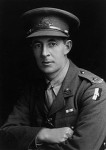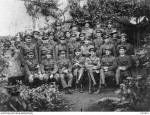CAMERON, Henry Gervais Lovett
Henry Gervais Cameron was the son of Verney Lovett Cameron, a solicitor practising at 30 Collins St.East, Melbourne, and his wife, Margaret Elizabeth, nee Fraser. He was born in Kew and educated at Melbourne Grammar School. In 1915, when he enlisted, Henry Lovett Cameron was 35 years old and appears to have been a businessman. His wife, Thyra ( nee Alexander) is nominated as his next of kin, with her address listed as care of Vale and Cameron, 5 Hamilton St., Sydney. They had married on 4 December, 1907, at Mosman, NSW, and had no children. He gave his own address as 'Rockleigh' in George St., East Melbourne. Today, the house is 'Braemar' at 178 George St., but then it appeared to be furnished rooms.There is no indication on his Embarkation Roll entry as to Henry Gervais Lovett Cameron's occupation, although an advertisement in the Sydney Morning Herald identifies Vale and Cameron as being Assayers. At Senior Officers School, he was described as 'An officer of determination, with a cheerful disposition; of smart and soldierly appearance'.
He enlisted in April, 1915, and was given the rank of 2nd Lieutenant and assigned to the 5th Battalion, 2nd Reinforcements. They set sail from Sydney on 25 June, 1915, on board HMAT Ceramic A40, for Egypt and the Gallipoli Peninsula. He arrived in September, 1915 and remained until the evacuation in mid-December. On his return to Egypt, he was transferred to the 57th Battalion and was promoted to Captain on 14 April, 1916. The 57th Battalion then transferred to France, embarking on HT Transylvania 17 June and landing at Marseilles on 25 June. From here, they were transferred to the battlefront and, as part of the 5th Division, went almost immediately into the front lines at the battle of Fromelles. The 5th Australian Division suffered 5,533 casualties.
There are two testimonials to Henry Lovett Cameron's leadership at Fromelles. One was from Brigadier General 'Pompey' Elliott: 'At Petillon on 19/20 July 1916 Capt. Cameron took parties both day and night to rescue wounded and by his coolness and daring was instrumental in rescuing a large number of wounded.' The other was from Lt. Col. J Duigan '... he personally led many rescue parties into No Man's Land to recover wounded men and salvage although continually sniped at with rifles and machine gun fire.' He was awarded the Military Medal.
On 19 August, Henry Lovett Cameron was again transferred, first to the 58th Battalion as Captain, then on to the 60th Battalion on 15 September. He was promoted to Major in the 60th Battalion on 23 September, 1916. By the next month, he was in hospital, first at Camiers, then, having been transferred back to England, at the 3rd London General Hospital, suffering from tonsillitis. On 14 December, he was released from hospital and sent to the No. 1 Convalescent Depot at Perham Downs. returning to France on 13 January, 1917. He rejoined the 6oth Battalion on 26 January, but in March, 1917, was sent back to England to attented the Officers School at Aldershot. In May, he was again in hospital, but finished the course on 16 June and was granted two weeks leave, then sent to 5th Division Headquarters as a Liason Officer, finally rejoining the 6oth Battalion on 5 October, 1917.
Henry Lovett Cameron served again in the front line with the 60th at the 2nd battle of Bapaume and at Polygon Wood on 26 September, 1917. The battalion was also engaged at Villers-Bretonneux on 25 April 1918. Again, the casualties were extremely high, and again, Henry Lovett Cameron showed enormous bravery. Major General J. Talbot Hobbs wrote of him 'At Villers-Bretonneux on 26 April when the commanding Officer and a large portion of his staff had become casualties and the enemy had broken through our line, Major Cameron took charge of the Battalion and after a personal reconnaissance ... formed a flank with his battalion, thereby saving the situation.'
With senior officers dead and wounded, Henry Cameron must have been a valuable member of the Brigade. He was transferred to the 56th Battalion with the temporary rank of Lieutenant Colonel. He reverted to Major when his command of the 56th ended. He took part in the final offensive of 8 August, the 100 Day Offensive, and remained until the armistice of 11 November. He was mentioned in Despatches in the London Gazette of 31 December 1918 and on 1 January 1919, was awarded the Distinguished Service Medal. He was also awarded an MBE in the New Year's Honors List of 1919.
He left France on 4 April 1919 and returned to Australia on 3 September, where his army service was terminated on 3 November, 1919. In 1934, he gave his address as Djaul Island, Kavieng, which is in the New Ireland province of New Guinea. Glimpses of him in the post-war years are limited: he does not appear on the Electoral Roll for some years, but from 1943-1949, he and his wife, Thyra, were living at Lorne, Victoria, first at Fern Avenue, then at Lower Marine Parade. In 1949, however, they moved inland to 14 Manifold St., Colac. Thyra died the following year, on October 5, 1950. Henry Gervais Lovett Cameron died on 9 February, 1966.
*Mark Rogers has provided the following information: 'The Djaul plantation on Djaul Island was possibly/probably owned by him - his nephew Harry Edward Lovett-Cameron MC was living there at the time he died in Rabaul Hospital in 1953'.
**Mark Rogers further information:
He was a mining assayer and analyst. From at least 1907 he was a partner in Vail and Cameron, assayers of Sydney. He resumed work as an assayer in 1919. The firm was still in practice in 1926.
By about 1929 he had moved to New Guinea where he was the owner of the Djaul coconut plantation on Djaul Island. He returned to Australia for a holiday in about Sep 1941, just as things were going pear-shaped in the Pacific.
TROVE references:
MINING. (1907, June 18). The Cobar Herald (NSW : 1899 - 1914), p. 2. Retrieved January 23, 2024, from http://nla.gov.au/nla.news-article118683101
Advertising (1919, September 24). The Sun (Sydney, NSW : 1910 - 1954), p. 2. Retrieved January 23, 2024, from http://nla.gov.au/nla.news-article221987752
Advertising (1926, September 11). The Daily Telegraph (Sydney, NSW : 1883 - 1930), p. 25. Retrieved January 23, 2024, from http://nla.gov.au/nla.news-article246350195
NEW GUINEA PLANTERS. Annual Conference., (20 September 1933). (1933-09-20). In Pacific islands monthly : PIM. IV (2), 32. Retrieved January 23, 2024, from http://nla.gov.au/nla.obj-328123111
ABOUT ISLANDS PEOPLE, (24 August 1934). (1934-08-24). In Pacific islands monthly : PIM. V (1), 15. Retrieved January 23, 2024, from http://nla.gov.au/nla.obj-328295100
CATHOLIC BISHOP'S DEATH, (16 September 1941). (1941-09-16). In Pacific islands monthly : PIM. XII (2), 50. Retrieved January 23, 2024, from http://nla.gov.au/nla.obj-332701086
Australian War Memorial Embarkation Roll, Honour Roll, Unit History, Photogaph Officers 60th battalion
Australian National Archives Service Record, photograph Henry Gervais Lovett Cameron
Mapping Our Anzacs
Trove SMH article 16/1/1917 p.6
Ancestry.com.au Birth, Marriage and Death Indexes, Electoral Rolls
Melbourne Grammar School Archives
Clan Cameron Australia website
Weekly Times, 4 Jan 1919, New Year Honors: http://nla.gov.au/nla.news-article221834491
Mark Rogers, emails 21/01/2024 ff.


